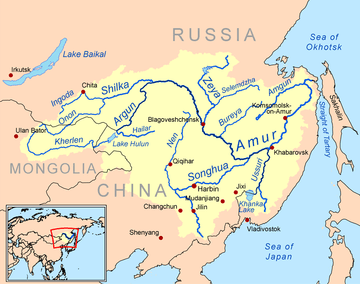Argun River (Asia)
| Argun (Ergune) | |
| River | |
 | |
| Name origin: Mongolian: ergene, "wide" | |
| Countries | China, Russia |
|---|---|
| Russian Krai | Zabaykalsky Krai |
| Chinese Region | Hulunbuir |
| Source | Kherlen River |
| - location | about 195 kilometres (121 mi) from Ulaanbaatar |
| - elevation | 1,961 m (6,434 ft) |
| - coordinates | CN 48°N 109°E / 48°N 109°E |
| Mouth | Amur river |
| Length | 1,620 km (1,007 mi) |
| Basin | 164,000 km2 (63,321 sq mi) |
| Discharge | |
| - average | 340 m3/s (12,007 cu ft/s) |
 | |
| Argun River | |||||||
 Argun River in the Amur basin | |||||||
| Chinese name | |||||||
|---|---|---|---|---|---|---|---|
| Chinese | 额尔古纳河 | ||||||
| |||||||
| Mongolian name | |||||||
| Mongolian | Эргүнэ мөрөн | ||||||
| |||||||
| Manchu name | |||||||
| Manchu script |
| ||||||
| Romanization | Ergune bira | ||||||
| Russian name | |||||||
| Russian | Аргу́нь | ||||||
The Argun or Ergune is a 1,621 kilometres (1,007 mi) river that forms part of the eastern China–Russia border, together with the Amur River (Heilong Jiang). Its upper reaches are known as Hailar River (Chinese: 海拉尔河; pinyin: Hăilā'ěr Hé) in China. The Ergune marks the border (established by the Treaty of Nerchinsk in 1689) between Russia and China for about 944 kilometres (587 mi), until it meets the Amur River.
Name
The name derives from Buryat Urgengol 'wide river' (urgen 'wide' + gol 'river').[1] Mongolian word "ergün" (in Traditional Mongolian alphabet) or "örgön" (in modern Mongolian) means "wide".
Geography
The river flows from the Western slope of the Greater Xing'an Range in China's Inner Mongolia, and forms the Chinese side of the two rivers that flow together to produce the Amur (Heilong). Its confluence with the Shilka River at Ust-Strelka on the Russian side forms the Amur River.
Kherlen–Ergune–Amur
In years with high precipitation, the normally exitless Hulun Lake may overflow at its northern shore, and the water will meet the Ergune after about 30 kilometres (19 mi). The Kherlen–Ergune–Amur system has a total length of 5,052 kilometres (3,139 mi).
History
In The Secret History of the Mongols is a legend related to the Ergüne hun Mongol ancestry. In this legend, the Mongols prevailed over other tribes and carried such slaughter among them, that in living remained no more than two men and two women. These two families, in fear of the enemy, fled to the inhospitable terrain, which included only mountains and forests and to which there was no road. Among those mountains was the abundant grass and healthy climate of the steppe. Then, legend tells that in Ergune-Khun, Mongols multiplied and become masters of iron smelting and blacksmithing. According to legend, it is the art of melting iron that has helped them escape from the mountain gorges on scope of the current Mongolian steppes, to the Kherlen (Kelulun) and Onon River.
Prior to the emergence of the Mongols, the Amur River basin was home to certain tribes of Jurchen people, who founded the Liao (907–1125) and Jinn (1115–1234) dynasties in northern China. The Manchu people who founded the Qing dynasty (1644–1912) additionally claimed descent from the Jurchens. Following the Russian conquest of Siberia in the 17th century, Russia-China relations were formalized in the 1689 Treaty of Nerchinsk, which established the Argun River as the China–Russia border. However, prior to the Amur Annexation of Outer Manchurian territory, China's border extended further to include the so-called Sixty-Four Villages East of the River in present-day Amur Oblast, southern Khabarovsk, and all of Primorsky Krai. Although the subsequent Amur Annexation fixed the eastern Sino-Russian border at the Amur, it would only be at the 1991 Sino-Soviet Border Agreement when all Sino-Soviet border conflicts would be resolved.[2]
References
- ↑ Pospelov, E.M. (1998). Geograficheskie nazvaniya mira. Moscow: Russkie slovari. p. 42.
- ↑ Perkins, Dorothy (2013). "Amur River (Heilongjiang)". Encyclopedia of China: History and Culture. Routledge. pp. 10–11.
Coordinates: 53°20′N 121°28′E / 53.333°N 121.467°E